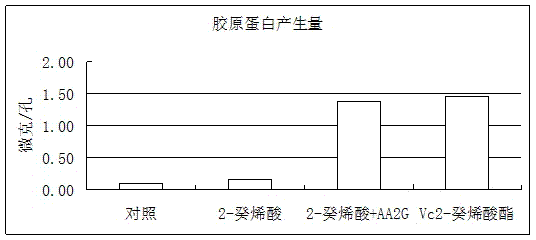L-ascorbic acid-6-(E-2-caproleic acid)ester or derivatives thereof and application thereof
A technology of ascorbic acid and decenoic acid, which is applied in the field of heterocyclic compounds, can solve the problems of undocumented neurotrophic factor-like effects and undisclosed decenoic acid derivatives, etc., achieve excellent activity in promoting adenoblast proliferation and increase bioavailability , the effect of increasing stability
- Summary
- Abstract
- Description
- Claims
- Application Information
AI Technical Summary
Problems solved by technology
Method used
Image
Examples
Embodiment 1
[0074] Example 1: Synthesis of L-ascorbic acid-6-(E-2-decenoic acid) ester.
[0075] Add E-2-decenoic acid (17.25g, 0.10mol) and L-ascorbic acid (22.91g, 0.13mol) into a four-necked flask, add 300ml of dichloromethane as a solvent, add 13.2g of triethylamine under stirring, and add chlorine Sulfoxide 15.4g. After the reaction was completed, the reaction solution was poured into 250ml of water, stirred and left to stand, the oil layer was separated, washed with 100ml×3 water, the solvent was removed, and recrystallized with ethanol to obtain white crystals.
[0076] The physical and chemical parameters of the product are:
[0077] MW328.36;
[0078] MS (m / z+) 328;
[0079] IR (v / cm) 2450~3600 (-OH), 1657 (-CH=CH-conjugated double bond), 1700 (C=O), 1675 (C=O, in the ring).
[0080] 1H NMR (CDCl3, ppm): 1.01(CH3, 3H), 1.20~1.75(br, 10H, -CH2-×5), 2.21(q, 2H, -CH2-), 3.73(O-C-H, 1H), 5.79( d, 1H, =CH-), 7.04 (dt, 1H, -CH=), 8.31 (=C-OH, 1H).
Embodiment 2
[0081] Example 2: Synthesis of 2,3,5-triacetyl L-ascorbic acid-6-(E-2-decenoic acid) ester.
[0082] Add 3.28g (0.01mol) of L-ascorbic acid (2-decenoic acid) ester into a four-necked flask, add 100ml of dichloromethane as a solvent, add 3.8g (0.036mol) of acetic anhydride dropwise under nitrogen protection under stirring, and the reaction is completed. The reaction solution was poured into 250ml of water, stirred and left to stand, the oil layer was separated, washed three times with 300ml of water, 100ml each time, the solvent was removed, and recrystallized with ethyl acetate to obtain 3.75g of the product, HPLC (high performance liquid chromatography) The measured content is 98.5%, and the yield is 81.2%w.
[0083] 2. The pure product of 3, 5-triacetyl L-ascorbic acid-6-(E-2-decenoic acid) ester is a white crystal, and its physical and chemical parameters are as follows:
[0084] MW454.47;
[0085] MS (m / z+) 454;
[0086] IR (v / cm) 1656 (-CH=CH-conjugated double bond), 1...
Embodiment 3
[0088] Example 3: Synthesis of L-ascorbic acid-6-(E-2-decenoic acid) ester derivatives.
[0089] As in Example 2, the synthesis of derivatives can all use known methods in the art, such as when the substituent is propionyl, propionylation can use propionic anhydride, propionyl halide + tertiary amine, etc. and L-ascorbic acid-6-( E-2-decenoic acid) ester is obtained by reaction, and the purification of the product can be realized by known methods such as chromatography and recrystallization, and the confirmation of the compound can also be determined by known methods.
PUM
 Login to View More
Login to View More Abstract
Description
Claims
Application Information
 Login to View More
Login to View More - R&D
- Intellectual Property
- Life Sciences
- Materials
- Tech Scout
- Unparalleled Data Quality
- Higher Quality Content
- 60% Fewer Hallucinations
Browse by: Latest US Patents, China's latest patents, Technical Efficacy Thesaurus, Application Domain, Technology Topic, Popular Technical Reports.
© 2025 PatSnap. All rights reserved.Legal|Privacy policy|Modern Slavery Act Transparency Statement|Sitemap|About US| Contact US: help@patsnap.com


